Nvidia will invest up to $100 billion in OpenAI as part of a strategic partnership that combines equity investment with chip purchases. The deal will fund a 10-gigawatt AI infrastructure using Nvidia's Vera Rubin platform, with deliveries starting in 2026.
Huge Investment and Strategic Partnership
The partnership between Nvidia and OpenAI is structured as two linked transactions: Nvidia will buy non‑voting shares in OpenAI, providing the AI lab with up to $100 billion in capital, and OpenAI will use that money to purchase Nvidia’s advanced GPU systems. This approach gives OpenAI access to cutting‑edge hardware without diluting control, while giving Nvidia a financial stake in OpenAI’s success. It also signals how dominant players are consolidating to secure scarce compute resources.
Building a 10 Gigawatt AI Infrastructure
The letter of intent calls for a deployment of at least 10 gigawatts of AI compute using Nvidia’s upcoming Vera Rubin platform. Analysts estimate that delivering this scale will require four to five million GPUs, dwarfing today’s largest data‑center projects. According to reporting, the first gigawatt is slated to come online in the second half of 2026, with shipments starting once the definitive agreement is finalised.
OpenAI CEO Sam Altman emphasised that "everything starts with compute" and said the arrangement will allow the company to train ever‑larger models and deliver new AI services to customers.
Implications for the AI and Hardware Market
The scale of the deal eclipses previous AI investments and could reshape the market for high‑end chips. By locking in vast GPU capacity years in advance, Nvidia and OpenAI are effectively raising the barrier to entry for other players. Commentators note that the investment is likely to attract regulatory scrutiny because it combines enormous financial power with control over critical AI infrastructure. Rival chipmakers and cloud providers may lobby regulators to ensure fair access to hardware.
Industry analysts also predict that the partnership will accelerate innovation. With guaranteed demand, Nvidia can push ahead with the Vera Rubin architecture and tailor it to OpenAI’s needs, while OpenAI can design algorithms that fully exploit the hardware’s capabilities.
Timeline and Next Steps
The first tranche of funding—around $10 billion—will be invested once a definitive agreement is signed, expected later this year. The remaining funds will be released as the 10‑gigawatt infrastructure is deployed. Shipments of the Vera Rubin platform will begin in late 2026, with the full build‑out continuing through the late 2020s.
For OpenAI users and developers, the partnership promises faster, more capable AI services in the coming years. For the broader tech ecosystem, it marks a new phase in the race for AI supremacy—one where compute capacity and strategic alliances are as important as algorithms.




